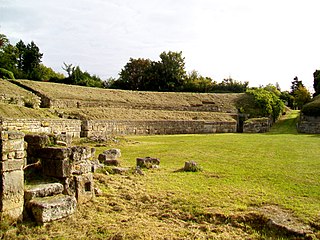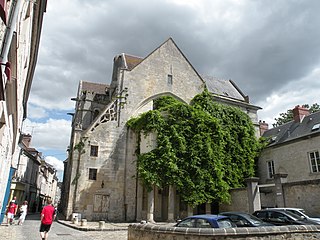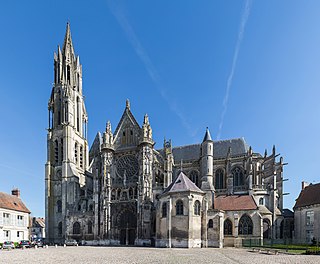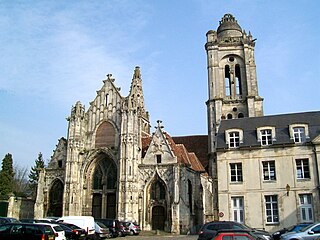Self-guided Sightseeing Tour #1 in Senlis, France
Legend
Tour Facts
1.7 km
39 m
Experience Senlis in France in a whole new way with our self-guided sightseeing tour. This site not only offers you practical information and insider tips, but also a rich variety of activities and sights you shouldn't miss. Whether you love art and culture, want to explore historical sites or simply want to experience the vibrant atmosphere of a lively city - you'll find everything you need for your personal adventure here.
Individual Sights in SenlisSight 1: Arènes de Senlis
The arenas of Senlis, built in the first century AD, are a small Gallo-Roman show building of ellipsoidal shape and semi-hollow type. They are located in Senlis and were rediscovered in 1865. Acquired and cleared by the Society of History and Archaeology of Senlis, they still belong to this association and can be visited under certain conditions.
Sight 2: Église Saint-Aignan
The Church of Saint-Aignan is a former Roman Catholic church located at 5-7 rue de Beauvais in Senlis (Oise), France. It was decommissioned during the Revolution, then its nave was demolished in 1806 and the rest of the building transformed into a theatre. Despite careful restoration during the 1980s and the development as a cultural space, the old church is now abandoned and forbidden to access for safety reasons. The historical importance of the remains lies in the role of the Romanesque bell tower of the eleventh century as a model for the other Romanesque bell towers in the region.
Sight 3: Église Saint-Frambourg

The Saint-Frambourg collegiate church in Senlis is an old royal chapel, which at the same time had a chapter of twelve canons appointed directly by the king, located in Senlis (Oise), in France. She was devoted to Saint Fraimbault, whose relics she kept. Its foundation is attributed to Queen Adelaïde, following the election of Hugues Capet in 987, in the same city. A Carolingian church is then demolished, to build the pre-Roman collegiate church with a western massif and a basilica nave. However, around 1177, the Adelaïde chapel had to give way to a more ambitious Gothic building whose construction was launched around 1169. This collegiate church follows a very simple plan, with single vessel, with a single level of elevation and five spans Doubles, but its dimensions are important for a chapel reserved for the royal family, in the chapter and veneration of many relics: it measures 46 m in length and 9.70 m wide inside, and is flooded with light. Its appearance is massive, powerful and elegant at the same time; Its architecture tables on harmonious proportions and a careful execution and does not give in to the temptation to impress by an abundant decoration. During its existence, the collegiate church does not undergo significant reshuffles. It is closed during the French Revolution, the dissolved chapter, and the building transformed into a temple of reason, before being sold as a national property. Towards the early 1820s, the building bell tower which was attached to the western facade to the north, was dismantled in order to sell the elements of sculpture. Serving as a merry -go -round, then workshop and warehouse, the old collegiate church is classified as a historic monument by the list of 1862. This classification has no impact on its preservation; What remains of the initial roof collapsed in 1914. apart from the installation of a flat coverage, Saint-Frambourg was not at all maintained, and in the post-war period, a body workshop occupies the monument. It is in this state of dilapidation that the virtuoso pianist of Hungarian origin György Cziffra acquired the old royal chapel in 1974, on the advice of André Malraux, to transform it into a audience. During a brief excavation campaign, vestiges of the two previous churches are uncovered, as well as Tower No. 9 of the Gallo-Roman enclosure which had to be leveled for the construction of the Gothic collegiate church. Interior catering was undertaken in 1976-1977, and followed by the inauguration to the public; It continued on the facade around 1980, and ended with the reconstruction of the roof in 2002. Since 2016, the Cziffra Foundation, created by the artist in 1975, became the owner of the premises. In conjunction with institutional partners, she offers a varied program of concerts, festivals and competitions throughout the year. It is focused on piano compositions and chamber music.
Sight 4: Senlis Cathedral
Senlis Cathedral is a Roman Catholic church and former cathedral in Senlis, Oise, France.
Sight 5: Église Saint-Pierre
The Church of Saint-Pierre is a former Roman Catholic church located in Senlis (Oise), France. It was deconsecrated during the Revolution and was used for various purposes, including that of a covered market. A municipal multipurpose hall since 1979, it was closed to the public in 2009 due to its poor condition, then reopened in May 2017 after eight years of work.
Share
Disclaimer Please be aware of your surroundings and do not enter private property. We are not liable for any damages that occur during the tours.
GPX-Download For navigation apps and GPS devices you can download the tour as a GPX file.



